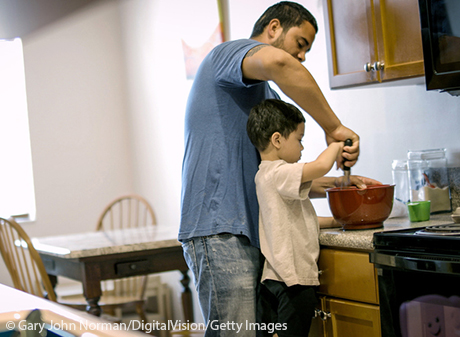The Household Shift from Paid Work to Home Production

This is the first post in a two-part series on how lost work hours affects time spent on home production activities.
The recession induced by the COVID-19 pandemic triggered sharp employment losses. With the loss of paid work, U.S. workers shifted to doing other things in their spare time. How did this affect home production, which includes activities such as child care, meal preparation, laundry and shopping?
St. Louis Fed Research Officer Oksana Leukhina and Zhixiu Yu, a Ph.D. candidate in economics at the University of Minnesota, explored this question in a Regional Economist article. Today’s post examines the extent to which American workers typically shift their time to home production when they lose their jobs or their working hours are reduced. Tuesday’s post will look at the estimated number and value of hours that shifted to home production activities because of the declining employment during the COVID-19 pandemic.
Impact of Work Shifts on Households May Vary
Using American Time Use Survey (ATUS) data from the Bureau of Labor Statistics for 2003-18, the authors looked at how workers spent their spare time in response to a job loss or reduced working hours.The authors noted that the ATUS has a lag between data collection and availability of about 14 months, so it has not yet collected pandemic data. “Nonetheless,” they wrote, “we can get a good sense of time allocation shifts during the pandemic by combining real-time data on work hours with the estimates of job loss effects on time use from 2003-10, a period that incorporates the Great Recession.”
The effect of lost working hours varies by household. For example, the authors wrote, single workers with less education might opt to spend the extra time taking a class, while married workers with children might decide to work on the backyard.
To account for these variations, the authors examined 20 different types of households based on the following characteristics:
- Marital status (single/married)
- Gender (male/female)
- Spousal employment (working/nonworking spouse)
- Education (less than a bachelor’s degree/bachelor’s degree)
- Presence of children in the household (kids/no kids)
Pre-Pandemic Home Production
Prior the pandemic, Americans spent an estimated 110 hours per week on sleep and leisure activities combined and 21 hours on home production, according to the authors. They then estimated how much these hours increased in response to a job loss or reduced working hours.
Depending on the type of household, home production activities took in 11% to 49% of lost market hours, they calculated. The authors found that the smallest effect was experienced by single women with no children and no bachelor’s degree, at 11%. Groups that shifted lost work hours to home production to the greatest degree were:
- Married women with children and no college degree, at 49%
- Married women with children and a college degree, at 45%
- Single men with children and no college degree, at 40%
- Married men with children, a college degree and a working spouse, at 38%
“For most groups, the majority of lost working hours are reallocated toward sleep and leisure activities such as watching TV, socializing and exercising,” they wrote.
The next post examines the estimated number and value of hours that shifted to home production activities during the early months of the pandemic.
Notes and References
- The authors noted that the ATUS has a lag between data collection and availability of about 14 months, so it has not yet collected pandemic data. “Nonetheless,” they wrote, “we can get a good sense of time allocation shifts during the pandemic by combining real-time data on work hours with the estimates of job loss effects on time use from 2003-10, a period that incorporates the Great Recession.”
Additional Resources
- Regional Economist: Home Production Activity during the COVID-19 Shutdown
- On the Economy: U.S. Population Growth Slowed Further in 2020
- On the Economy: What Explains Rising Returns to High-Quality College Education?
Citation
ldquoThe Household Shift from Paid Work to Home Production,rdquo St. Louis Fed On the Economy, Jan. 18, 2021.
This blog offers commentary, analysis and data from our economists and experts. Views expressed are not necessarily those of the St. Louis Fed or Federal Reserve System.
Email Us
All other blog-related questions

